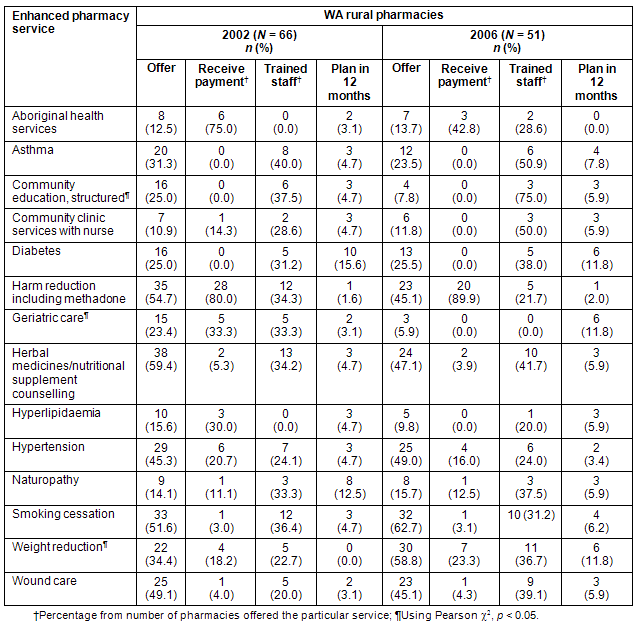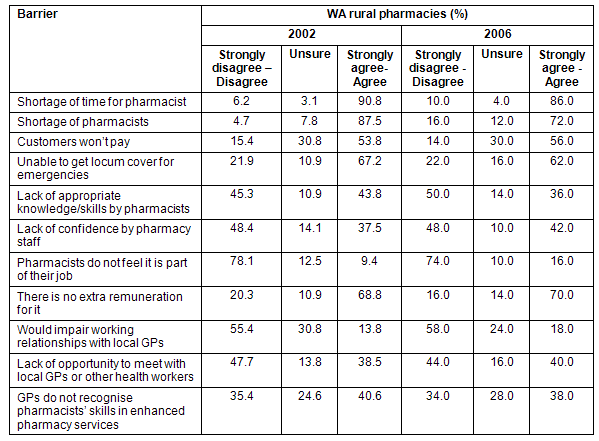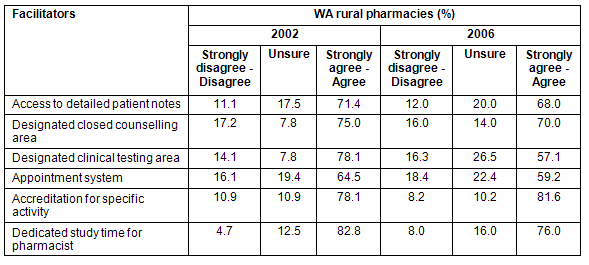Introduction
Community pharmacies in Australia have developed a range of extended or enhanced pharmacy services (EPS) to satisfy demands for health services other than the routine issuing of medicines1. Enhanced pharmacy services refers to health-related services above those normally available with the supply of medicines which require additional or particular skills, knowledge and/or facilities and are provided to sub-groups with special needs1,2. In Australia, many EPS, such as wound management and smoking cessation, are recognised, defined and described for implementation in community pharmacies2. A national survey conducted in 2002 reported that over 40% of Australia's community pharmacies offered EPS in the areas of asthma, diabetes, harm reduction with methadone, herbal medicines counselling, hypertension and wound care. Other services provided by 20% to 40% of pharmacies included community education, geriatric care, naturopathy, pain management, osteoporosis, skin care and weight reduction management. The survey analysed barriers to providing EPS and these included lack of time, a shortage of pharmacists, no extra remuneration or the inability to find locums1,2.
The rural and remote population in Australia constitutes approximately 32% of the whole population3. The Australian Institute of Health and Welfare (AIHW) reported that rural populations in Australia commonly are of lower socio-economic and health status than those living in urban areas3. Community pharmacies play an important role in maintaining rural health because access to primary health care is often limited in rural areas4. It has been reported that rural pharmacists provide a greater diversity of health care compared with their urban counterparts5,6.
Community pharmacists rank with doctors as the most frequently consulted health professionals and are considered important to rural communities7,8. Pharmacists facilitate self-care and are frequently the first-contact primary care health professional2,9 necessitating basic assessment of symptoms, issuing advice and/or medicines or referral, usually to a medical practitioner9. The potential for community pharmacists to become systematically involved in disease state management is currently being trialled in community pharmacies10,11. Evidence has been found that rural community pharmacies provide a low frequency of health promotion advice based on opportunity. However, when provided, the advice was satisfactory12.
Providing information on the involvement of rural pharmacy in EPS will assist government and pharmacy bodies to design policies and programs that will improve community access to pharmacy services and, therefore, reduce rural health inequalities13.
The aims of this study were to comparatively evaluate the provision of EPS, and their facilitators and barriers in rural pharmacies in Western Australia (WA) in 2006, compared with the findings concerning rural WA pharmacies extracted from a national 2002 survey.
Method
A questionnaire was developed from the 2002 survey questionnaire to collect data on EPS from pharmacies in rural and remote WA2. It consisted of 9 pages, four sections and 32 questions. The questionnaire and approval for the survey was provided by the Curtin University of Technology, Human Research Ethics Committee.
One questionnaire was mailed to the pharmacist proprietor/manager of all 103 rural and remote pharmacies in WA in October 2006, followed by two subsequent mailings in November 2006 to non-responders; 51 questionnaires (49.5%) were returned. The 2002 data used for comparative analysis included 82 pharmacies from the same cohort, of which 66 responded (80.5%). These were extracted for the present study from Australia's National Pharmacy Database Project, a national survey of community pharmacies performed in 2002 ('2002 survey')2. The PhARIA classification (6 groups of pharmacies in Australia categorised by remoteness) of the 2006 pharmacies in the pool and the sample were compared for respondent bias.
Data analysis
Statistical analyses were performed using SPSS for Windows v14 (SPSS Inc; Chicago, IL; USA; www.spss.com). Frequencies and percentages of responses were generated for each question from the 2006 questionnaire, and for matched questions from the 2002 questionnaire. If responses were continuous and numerical, descriptive statistics were generated (mean, standard deviation, median, minimum and maximum score).
Cross tabulations by year of survey (2002 and 2006) were performed for questions in the survey pertinent to 'EPS'. To test individual associations between years of survey against provision of each EPS, Pearson χ2 tests were conducted (where expected cases were less than 5, Fisher's exact test was used). Where significant associations were reported from the χ2 tests between year of survey and provision of a particular service, logistic regression was performed. Due to the limited sample size, only a few factors were included in the logistic regression to control for any effects between year of survey and frequency of service provision. Four variables (sex, age, PhARIA location and inclusion of a forward pharmacy area) were selected for analysis because the 2002 national survey data indicated that those variables influenced service provision1,2,14.
Results
Individual response rates for the 2006 survey were PhARIA 1: 6/18 (33%); 2: 12/16 (75%); 3: 7/17 (41.1%); 4: 6/14 (43%); 5: 10/18 (56%); and 6: 10/20 (50%). Non-respondent pharmacies were not different in terms of PhARIA (p=0.22). There were marginally less non-responders in PhARIA 2 (the second most accessible groups of pharmacies; p=0.03) based on logistic regression which had an overall p=0.26.
Enhanced pharmacy services were reported by WA rural pharmacists in the 2002 and 2006 surveys, with details of trained staff, fees charged and services planned for introduction within 12 months from December 2006 (Table 1). More than 20% of pharmacies in the 2002 and 2006 surveys offered EPS for asthma, diabetes, harm reduction with methadone, herbal medicines/nutritional supplement counselling, hypertension, smoking cessation, weight reduction and wound care.
Table 1: Comparison of Western Australian rural pharmacies that offered enhanced pharmacy services by trained staff, fees charged and planning in 12 months, in 2002 and 2006

The provision of weight reduction services showed a marked increase from 34.4% in 2002, to 58.8% of pharmacies in 2006 (p=0.009). After controlling for sex, age, PhARIA location and inclusion of a forward pharmacy, pharmacies in 2006 were 1.37 times (95% CI = 1.109-1.695) more likely to provide the services as those in 2002. Among pharmacies offering weight management, a higher percentage of pharmacies reported they received payment in 2006 than 2002 (23.3% vs 18.2%, respectively), and had trained or accredited staff (36.7% vs 22.7%, respectively).
However, geriatric care was provided by a lower percentage of pharmacies in 2006 than in 2002 (p=0.010). After controlling for sex, age, PhARIA location and inclusion of a forward pharmacy, pharmacies in 2006 were less likely to provide geriatric care than those in 2002 (OR = 0.690; 95% CI = 0.493-0.966). Of pharmacies offering this service in 2002, 33.3% either received payment or had trained staff, while in 2006, none of the pharmacies either received payment or had trained staff for geriatric care.
Structured community education was provided by 25% of pharmacies in 2002, but this decreased to 7.8% in 2006 (p=0.016). After controlling for sex, age, PhARIA location, and inclusion of a forward pharmacy, pharmacies in 2006 were less likely to provide structured community education than those in 2002 (OR = 0.677; 95% CI = 0.493-0.932). None of these pharmacies reported receiving a fee for particular service and a higher percentage of pharmacies had trained staff in 2006 compared with 2002 (75.0% vs 37.5%, respectively).
For most of the services (asthma, community education, community clinic with nurses, diabetes, herbal medicines, naturopathy, hypertension, weight reduction, smoking cessation, and wound care), the percentages of pharmacies with trained staff were higher than those that received payment. Of the 35 pharmacies and 23 pharmacies that provided harm reduction in 2002 and 2006, respectively, the majority received payment (80.0% and 86.9%, respectively) and smaller percentages had trained staff (34.3% and 21.7%, respectively).
In the 2002 survey the following EPS were planned to be introduced by at least 4% of rural pharmacies in the 12 months from July to September 2003: diabetes (15.6%); naturopathy (12.5%). In addition, 5.4% planned asthma, community health education, community clinic with nurses, herbal medicines, hyperlipidaemia, hypertension or smoking cessation. In the 2006 survey, 11.8% of pharmacies planned to offer diabetes, weight reduction and geriatric care EPS programs within 12 months, followed by asthma (7.8%) and smoking cessation (6.2.%), and 5.9% of pharmacies planned to offer community health education, community clinic services, herbal medicines, hyperlipidaemia, naturopathy or wound care.
In both surveys, the major barriers to providing EPS were (in order): lack of time, a shortage of pharmacists, no extra remuneration, and the inability to get locum cover for emergencies. The barriers considered least important were 'not felt to be part of their job' and 'it may impair their relations with GPs (Table 2).
In the 2002 survey, the facilitators that most strongly supported for EPS were 'accreditation', 'dedicated study time', 'clinical testing area' and 'closed counselling area'. Similar findings were reported for the 2006 survey, except for 'clinical testing area' (Table 3).
Table 2: Comparison of barriers to enhanced pharmacy services reported by Western Australian rural pharmacies in 2002 and 2006

Table 3: Comparison of facilitators for enhanced pharmacy services reported by Western Australian rural pharmacies in 2002 and 2006

Discussion
The distribution of questionnaire respondents according to remoteness was similar in 2002 and 2006 surveys. Rural pharmacies in WA were providing a range of EPS in both 2002 and 2006. However, with some exceptions, these remained static over the two survey periods. Enhanced pharmacy services were in addition to extensive medication-related services provided by the rural pharmacies in both surveys. It was considered that enhanced pharmacy services were more important in rural and remote locations because their availability from other sources was limited.
There inconsistencies between the prevalence of certain risk factors and disorders in rural Australia and the rates of provision of corresponding EPS by rural pharmacies in WA. The National Health Priorities Areas (NHPAs) include asthma, mental health, cardiovascular health, cancer control, diabetes, injury prevention and control, arthritis and other musculoskeletal conditions3. The AIHW has reported that the prevalence of cardiovascular diseases, diabetes, respiratory diseases, and other chronic conditions is higher in rural than in urban areas3, and this is related to a higher prevalence of health risk factors among rural populations, such as smoking, obesity and physical inactivity3,15,16. The 2002 survey, however, showed that less than 50% of WA rural pharmacies were offering EPS that corresponded to NHPAs and rural health issues (asthma, weight reduction, diabetes, hypertension, hyperlipidaemia). Only 'smoking cessation' was offered by more than 50% of pharmacies.
The provision of asthma, diabetes, hypertension, and hyperlipidaemia did not show significant changes over the survey period. However, the proportion of pharmacies that provided weight management services increased significantly. Weight management ranked first with diabetes and geriatric care among services planned within a 12 month period. The increased uptake of weight management services in rural pharmacy practice is appropriate because approximately 60% of Australian adults were either overweight or obese in 200417, and this is more likely for those living in a rural area3,18. Concomitant with the higher provision of weight management services in rural pharmacy practice, more pharmacies in 2006 reported having trained staff for the service. The increase in pharmacies with staff trained offering weight management in rural WA may be related to the introduction of a national program 'Lifeweight' in March 2004, which coincided with the change in classification of orlistat (an effective non-prescription weight reduction agent that acts by inhibiting fat uptake) from a medically prescribed product to 'pharmacist only' (S3) in May 200417.
It was of concern that rural pharmacies have insufficient numbers of trained staff to provide EPS services, with many pharmacies providing EPS without specifically trained staff. Despite an increase in the availability of trained staff in the 2006 survey this deficiency must be addressed.
Due to the low rates of some EPS relative to the rural health issues found in both surveys, a decision was made to analyse the factors which have prevented (barriers) and facilitated (facilitators) the involvement of rural pharmacies in EPS. In 2002, the most highly rated facilitators were: allocation of study time, accreditation, clinical testing and the presence of a counselling area. The most highly rated barriers were: time constraints, a shortage of pharmacists, no extra remuneration or the inability to find locums. Over the period of the two surveys, the reported facilitators and barriers remained remarkably constant. The consistency of facilitators and barriers is important information for policy-makers in their efforts to facilitate increased provision of EPS to rural communities.
The shortage of pharmacists and associated lack of time were the major barriers reported in both surveys. Comparisons were made of the number of full-time equivalent (FTE) pharmacists per WA rural pharmacy in 2002 and 2006. This was calculated on the basis that 1 FTE pharmacist worked for 50 hours per week, which was the median of rural pharmacy opening hours per week in 2006. While it was found that the number of FTE pharmacists per WA rural pharmacy had increased marginally (from 1.49 in 2002 to 1.66 in 2006) this was inadequate to remove these major identified barriers and may explain the low number of patients receiving health promotion advice12. Clearly, targeted programs are required to increase the number of rural pharmacies with trained staff involved in EPS that respond to the greatest rural health needs. Pilot disease management programs for asthma and diabetes have subsequently commenced in community pharmacies in Australia10,11. The impact of these programs in rural WA is yet to be reported.
It is probable that promotion campaigns played a role in increased uptake of important services. For example, the introduction of the 'Lifeweight' program was a likely factor in increasing pharmacies' involvement in weight testing and weight management services17. However, wound care, which was an EPS of low frequency in the national survey for all pharmacies, was reported by more than 40% of rural pharmacies in both the 2002 and 2006 surveys, demonstrating the success of organised promotion of a service19. Clearly, a marked increase in uptake of services can occur if extensive implementation support is provided.
Conclusion
In the 2002 and 2006 surveys, WA rural pharmacies provided a wide range of EPS. There were notable increases in weight testing and weight management services. Smoking cessation was offered by more than 50% of pharmacies, and increased over the period 2002 to 2006. Some other EPS (for asthma, diabetes, hypertension, hyperlipidaemia), which corresponded to Australia's health priorities and rural needs, were only reported by low percentages of pharmacies in both surveys. A shortage in the pharmacist workforce has remained a barrier to their provision, as evidenced by the barriers and low figures of FTE pharmacists per WA rural pharmacy across the two surveys. This issue reduces the provision of valuable health services to rural communities. The provision of staff training support for these important services is essential for uptake by the profession.
References
1. Berbatis CG, Sunderland VB, Joyce A, Bulsara M, Mills C. Enhanced pharmacy services, barriers and facilitators in Australia's community pharmacies: Australia's national pharmacy database project. International Journal of Pharmaceutical Practice 2007; 15: 185-191.
2. Berbatis C, Sunderland B, Mills C, Bulsara M. National pharmacy database project. Perth, WA: Curtin University of Technology, 2003. Available: http://www.guild.org.au/research/project_display.asp?id=239 (Accessed 3 May 2010).
3. Australian Institute of Health and Welfare. Australia's health 2008. AIHW cat. no. AUS 99. Canberra, ACT: AIHW, 2008; 80-87.
4. Knapp K, Paavola F, Maine L, Sorofman B, Politzer R. Availability of primary care providers and pharmacists in the United States. Journal of American Pharmaceutical Association 1999; 39: 127-35.
5. Emerson L. Working with rural and remote area pharmacists ....how do you do it? In: Proceedings, Rural and remote Australia: health for all by the year 2000. 4th National Rural Health Conference; 9-12 February 1997; Perth, WA. Perth: National Rural Health Alliance, 1997.
6. Mahoney P. Pharmacy services to multipurpose services and Aboriginal health care. In: Proceedings, Rural and remote Australia: health for all by the year 2000. 4th National Rural Health Conference; 9-12 February 1997; Perth, WA. Perth: National Rural Health Alliance, 1997.
7. Smith KB, Humphreys J, Lenard Y, Jones JA, Prince V, Han GS. Still the doctor - by a country mile! Preferences for health services in two country towns in north-west New South Wales. Medical Journal of Australia 2004; 181: 91-95.
8. Strasser R, Harvey D, Burley M. The health service needs of small rural communities. Australian Journal of Rural Health 1994; 2: 7-13.
9. Berbatis CG, Sunderland VB. Community pharmacy's contribution to health in Australia: Population studies of non-dispensing primary care. Australian Pharmacy 2008; 27: 946-951.
10. Pharmacy Guild of Australia. The diabetes pilot program: diabetes medication assistance service. (Online) no date. Available: http://www.guild.org.au/pps/content.asp?id=1896 (Accessed 31 March 2009).
11. Pharmacy Guild of Australia. The asthma pilot program: pharmacy asthma management service. (Online) no date. Available: http://www.guild.org.au/pps/content.asp?id=2029 (Accessed 31 March 2009)
12. Sunderland B, Burrows S, Joyce A, McManus A, Maycock B. Rural Pharmacy not delivering on its health promotion potential. Australian Journal of Rural Health 2006; 14: 116-119.
13. Pharmacy Guild of Australia. The rural and remote pharmacy workforce development program. (Online) no date. Available: http://www.grantslink.gov.au/Info.aspx?NodeID=6&ResourceID=1117 (Accessed 19 July 2010).
14. Berbatis CG, Sunderland VB, Joyce A, Bulsara M, Mills C. Characteristics of Australia's community pharmacies: National Pharmacy Database project. International Journal of Pharmacy Practice 2007; 15: 265-271.
15. Strong K, Trickett P, Titulaer I, Bhatia K. Health in rural and remote Australia: the first report of the Australian Institute of Health and Welfare on rural health. Canberra, ACT: AIHW, 1998. Available: http://www.aihw.gov.au/publications/index.cfm/title/3420 Accessed 3 May 2010).
16. Wilkinson D, Blue I. The new rural health. Melbourne, VIC: Oxford University Press, 2002.
17. Berbatis C. Weight management challenges to Australian pharmacy. Australian Pharmacy 2005; 24: 196-201,242.
18. National Health and Medical Research Council. Clinical practice guidelines for the management of overweight and obesity in adults. Canberra, ACT: NHMRC 2003. Available: http://www.nhmrc.gov.au/your_health/healthy/nutrition/guidelines.htm (Accessed 3 May 2010).
19. Sussman G. Wound management and the physiology of healing. Current Therapeutics 2000; 41(5): 12-19.
Abstract
Introduction:
Enhanced pharmacy services (EPS) are health related services above those normally available with the supply of medicines. Rural pharmacies could provide a diversity of EPS in response to the limited access and reduced health services available in rural areas. The objective of this study was to evaluate the provision of EPS in rural Western Australian (WA) pharmacies in 2006, compared with findings extracted from a national survey conducted in 2002. Barriers to and facilitators for the provision of ETS in rural settings were also analysed.Methods: The survey was conducted in 2006, using a questionnaire developed from a 2002 Australian national survey questionnaire. The questionnaires were mailed to all 103 pharmacies in rural WA and 51 were returned (49.5%). Chi-squared tests were used to test associations between year of survey and provision of each EPS. Where significant associations were reported, logistic regression analyses that controlled for sex, age, PhARIA location (remoteness), and inclusion of a forward pharmacy area were performed.
Results: The WA rural pharmacies offered a range of EPS. There were marked increases in weight testing and weight management services. The availability of smoking cessation services increased from 52% of rural pharmacies in 2002 to 63% in 2006. Other EPS (asthma, diabetes, hypertension, hyperlipidaemia), which correspond to the Australian Government National Health Priorities Areas were offered by 20% to 50% of pharmacies and had not increased between surveys. A continued shortage in the pharmacist workforce was a major barrier to EPS provision.
Conclusions: Provision of EPS in rural pharmacies is more important than in metropolitan pharmacies because there is often a lack of other sources for these services in rural and remote locations. A range of defined EPS were provided by 25% to 60% of rural and remote pharmacies, with other services offered in lower percentages. Significant increases were found in some important EPS, such as weight management. Additional support for EPS provision in rural and remote communities is required to increase uptake among pharmacists. Government and pharmacy bodies need to implement rural practice models to address identified pharmacist workforce barriers and improve access to EPS to rural communities.
Key words: community pharmacy, pharmacists, primary care, Western Australia.



